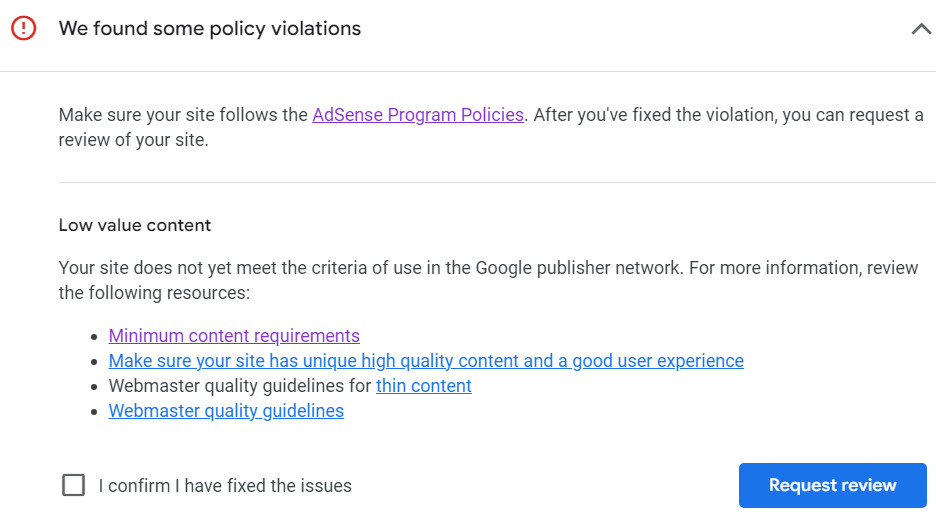
To fix the “Low value content” issue flagged by AdSense, you’ll need to improve your website to meet Google’s content quality and user experience standards. Here are steps you can take:
1. Enhance Content Quality
- Create unique, original content: Ensure that your content is not copied or scraped from other websites. Write articles or pages with a unique perspective or added value.
- Focus on depth and usefulness: Each page should provide value to the user. For example, if it’s an article, it should be detailed, well-researched, and provide actionable insights or solutions.
- Cover a niche: Instead of trying to cover broad topics, focus on a specific niche and become an expert in that area. Specialized, well-crafted content is more likely to be seen as valuable.
2. Increase Content Quantity
- Build out content-rich pages: Ensure your site has a sufficient number of well-written pages. A blog with only a few posts may be considered “thin content.”
- Target keywords effectively: Conduct keyword research and write content around terms that your target audience is searching for.
- Avoid “placeholder” pages: Pages with little to no content (like “coming soon” pages) should be removed or replaced with substantive content.
3. Improve User Experience
- Optimize site navigation: Ensure your site is easy to navigate. Use clear menus, categories, and search functionality.
- Mobile responsiveness: Make sure your website is fully responsive and provides a good experience on mobile devices.
- Speed optimization: Improve page load times using tools like Google PageSpeed Insights or GTmetrix. A slow website can hurt user experience and SEO.
4. Follow Webmaster Quality Guidelines
- Avoid “thin content”: Pages with little content, duplicate content, or autogenerated material are considered low-value.
- Eliminate spammy elements: Remove irrelevant ads, excessive affiliate links, or anything that might look like spam.
- Check for plagiarism: Use tools like Copyscape to ensure all your content is original.
5. Visual Appeal
- Add media: Use high-quality images, videos, and infographics to make your site more engaging and visually appealing.
- Format for readability: Break up content into smaller paragraphs, use headings, bullet points, and white space for better readability.
6. Build Authority
- Add an “About Us” page: Include details about your website, its mission, and who is behind it. This builds credibility.
- Include a “Contact Us” page: Ensure users and Google can see your site as trustworthy.
- Develop backlinks: Gain backlinks from reputable websites to signal authority to search engines.
7. Monetization Policy Compliance
- Limit ads initially: A site with excessive or intrusive ads can be flagged as low value. Focus on improving your content before adding more ads.
- Check for policy violations: Ensure your site complies with all of AdSense’s program policies. For example, avoid adult, copyrighted, or sensitive content.
8. Request a Review
Once you’ve improved your site, follow these steps to request a review:
- Login to your AdSense account.
- Go to “Policy Center”.
- Find the violation notice.
- Click “Request Review”.
- Provide a clear explanation of the changes you’ve made to address the issue.
Read website builder reviews and pick the best website builder for you at ChooseWebsiteBuilder.com !













